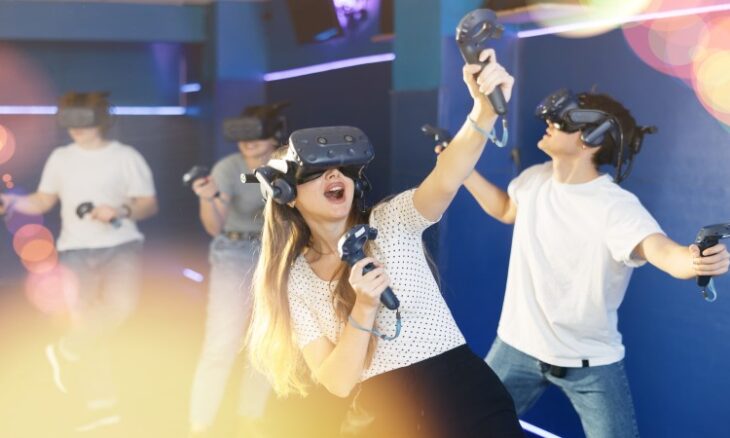Virtual reality’s leap into entertainment draws closer
Virtual reality, once hailed as the future of entertainment, may finally be approaching its long-awaited breakthrough. When the Oculus Rift made its debut over a decade ago, it carried with it the promise of a revolution in media consumption. Yet, for much of the time since, VR has remained on the fringes of mainstream use. Now, developments by major players in both tech and media suggest that immersive technology may be near.
Recent reports indicate that Meta is in active discussions with major entertainment studios, including Disney and A24, to create virtual content for its Quest headset. Apple, meanwhile, unveiled new sharing capabilities for its Vision Pro headset in June, allowing multiple users to experience 3-D media together. Earlier in the year, the company premiered a fully immersive Metallica concert and has confirmed a performance upgrade to its Vision Pro, expected to roll out soon.
These moves reflect a sustained belief among industry leaders that audiences may soon embrace paying premium prices for immersive experiences such as concerts, live sports, and films presented in ways traditional screens cannot replicate.
Since Oculus first launched its Rift headset, VR hardware has steadily evolved, becoming lighter, faster, and more powerful. Alongside these hardware improvements, interest in storytelling through VR is slowly growing among media producers. Meta recently experimented with virtual rinkside tickets for Stanley Cup games, following similar trials in NBA and WNBA events. Apple and Meta have also offered virtual concerts, with artists like Alicia Keys and Blackpink participating. Disney integrated its Disney+ platform with the Vision Pro right from the start of 2024, further signalling interest in immersive formats.
Historically, the VR sector has struggled with a classic chicken-and-egg dilemma: content creators are reluctant to invest in virtual productions without a sizable audience. At the same time, consumers are less likely to buy headsets without compelling content. Executives within the industry, however, suggest this cycle is beginning to shift. Meta’s VR content division points to the regular integration of mixed reality experiences into everyday routines as evidence of slow but steady momentum.
Market data from IDC showed a 10% increase in global AR and VR headset shipments in 2024, rising to 7.5 million units. In the US, that figure grew nearly 31% to 3.4 million. Although a dip in shipments is anticipated in 2025 due to product delays, a significant rebound is forecasted for 2026, with global shipments projected to climb 98.5% to 11.3 million units.
Despite these signs of growth, financial outcomes remain uneven. Meta’s ambitious push into the metaverse has cost the company $46 billion over the past three years. Its Reality Labs division recorded an operating loss of $4.2 billion in the first quarter of 2025 alone, generating only $412 million in sales. Still, investments continue. Meta allocated $3.5 billion to eyewear firm EssilorLuxottica SA, while Snap prepares to launch a new line of AR glasses. Google, too, remains active in the sector, partnering with Samsung and Xreal on devices that will run on the recently unveiled Android XR system. Samsung’s own offering, currently dubbed Project Moohan, is expected soon.
Industry veterans argue that the infrastructure is ready; now, adoption is the missing piece. With hardware sophistication no longer a major obstacle, companies are banking on increased consumer participation to drive the next stage. The argument for exclusive content remains strong. Industry advisors suggest that just as streaming platforms grew through unique offerings, VR may follow a similar path. Tailored, immersive experiences are expected to be the key, rather than simply repurposing 2-D media.
Sporting events present one of the most straightforward opportunities to bridge the gap with mainstream audiences. Several immersive production companies already use 180-degree camera systems to bring virtual sports to viewers, whether live or replayed. As viewership grows, the infrastructure to deliver such experiences is already in place.
The broader entertainment industry is increasingly eyeing VR as a potential new revenue stream in an evolving media landscape. With cinema attendance fluctuating and cable models continuing to erode, immersive platforms may offer an alternative avenue for premium content distribution. Some see this as an urgent need, with current entertainment structures undergoing significant change.
However, progress has been hampered by inconsistent investment. Over the past decade, emerging technologies like AI and autonomous vehicles have attracted the bulk of funding. Crunchbase data indicates that AI and self-driving investments soared from just under $40 billion in 2019 to more than $105 billion in 2025. By contrast, XR funding peaked at just over $4 billion in 2021 and has since dropped below $350 million.
Venture capital trends reveal a similar pattern. PitchBook data shows that 2019 was VR’s best year in terms of venture capital, securing $6.43 billion in global deals, far behind the $57 billion flowing into AI. By 2025, that gap had widened, with VR VC deals falling to $3.61 billion and AI rising to over $130 billion. Still, industry insiders believe the tide is turning, as XR begins to receive renewed attention in investment circles.
As companies navigate hardware development and content production, a central challenge remains: convincing everyday users that VR headsets are worth both the financial cost and the physical commitment of wearing them. This is one reason Apple continues to position its Vision Pro as a productivity tool, promoting spatial computing functions over pure entertainment value.
Even as the hardware evolves and content libraries expand, no consensus exists around when VR will fully break through. Some believe the shift could occur imminently; others suggest it may take several more years. Yet, among those building the future of immersive content, there is a growing conviction that the traditional 2-D experience may soon be seen as a relic of the past.










